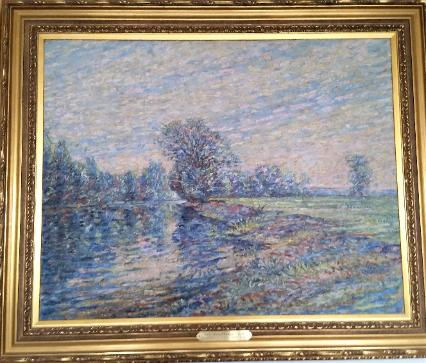Ernest Lawson

Gallery Database:
Ernest Lawson (1873-1939). "Bronx River: Reflections
of Spring," oil on canvas, 24 x 30, signed.
THE MOST BRILLIANT
AND BEAUTIFUL LAWSON LANDSCAPE THERE IS!
Curator's Comments:
We are pleased to have a Lawson back to offer, having sold a view in the Colorado series focused on the Silver Dollar Mine at Cripple Creek. Our new offering is early, a view of the upper Bronx River, and impressive for its joyous tones that blend sky, riverbank, and the meadow. Lawson was born in Halifax, studied in France, but came under the influence of Twachtman at the Art Students League in New York in 1890. From 1893 to 1898, he studied in Paris at the Academy Julian. In Paris, he shared a studio with Somerset Maugham, who used him as the prototype for Frederic Lawson in his novel, Of Human Bondage. By 1898, he had moved to New York City's Washington Heights section, where countryside and river views still dominated. The Bronx River flows south from upper Westchester, past White Plains, then south-southwest through the northern suburbs, passing Tuckahoe, Eastchester, and Bronxville, before emptying into the East River. Lawson favored this area, perfectly pastoral during his residence, and further south he painted the Harlem River that divides Manhattan and the Bronx. He participated in both the landmark exhibition of The Eight in 1908 and the Armory Show of 1913. But, as in the work of his best friend Glackens, his art has little to do with Ashcan Realism. Impressionism remained his metier, and his focus was typically on landscape. Lawson left New York, painting and traveling widely, until he settled in Florida at the close of his career.

Arm of the Harlem River
sold for $114,000

The Artist, ca. 1925
We think of Lawson, along with Redfield and Schofield, as one of the three preeminent U.S. landscape artists in the first half of the 20th century. These painters achieved a breakthrough, going far beyond naturalism, tonalism, and even impressionism to create the unique mode of expression that we call art. Lawson's impasto technique is thickly layered onto the canvas, in what is clearly a very fine representation of what critic J.G. Huneker called coloration "made from crushed jewels." What is surely magical about the painting we offer is that it gleams a total cobalt-pink-yellow and bright verdant green when illuminated by horizontal beams of daylight. This work is one of the finest examples of Lawson's brushwork and impasto that we have ever seen. Throughout the texture is magnificent. The light blue cobalt of the sky reflects into the deeper cobalt of the river that throws reflection onto the stony bank in a cobalt blue of medium hue that brightens the green shades that reflect back up to the glowing sky. The effect is a truly wondrous experience for the eye. The signature is rendered in the cobalt hue and is readily seen in natural light when the painting is laid flat. But when the painting is hung it blends into the riverbank, where Lawson partially disguised it. We are pleased to quote a condition report on the current work prepared by the noted restorer Simon Parks: "This painting is in perfect condition. The canvas has never been removed from its original stretcher. The paint layer is clean and is not only stable, but has not been retouched and unusually for a work by Lawson, has no disturbing cracking or distortion. The picture should be hung as is." Enough said-this is a painting you want to own.
